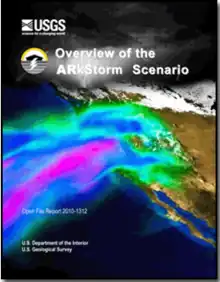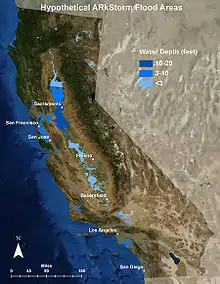ARkStorm
An ARkStorm (for Atmospheric River 1,000) is a "megastorm" proposed scenario based on repeated historical occurrences of atmospheric rivers and other major rain events first developed and published by the Multi-Hazards Demonstration Project (MHDP) of the United States Geological Survey (USGS) in 2010[1] and updated as ARkStorm 2.0 in 2022.[2]

ARkStorm 1.0 (2010 Study)
The ARkStorm 1.0 scenario describes an extreme storm that devastates much of California, causing up to $725 billion in losses (mostly due to flooding), and affecting a quarter of California's homes. The scenario projects impacts of a storm that would be significantly less intense (25 days of rain) than the California storms that occurred between December 1861 and January 1862 (43 days). That event dumped nearly 10 feet (3,000 mm) of rain in parts of California.[3][4]
USGS sediment research in the San Francisco Bay Area, Santa Barbara Basin, Sacramento Valley, and the Klamath Mountain region found that "megastorms" have occurred in the years: 212, 440, 603, 1029, c. 1300, 1418, 1605, 1750, 1810, and, most recently, 1861–62. Based on the intervals of these known occurrences, ranging from 51 to 426 years, for a historic recurrence of, on average, every 100-200 years.[3]
Geologic evidence indicates that several of the previous events were more intense than the one in 1861–62, particularly those in 440, 1418, 1605, and 1750, each of which deposited a layer of silt in the Santa Barbara Basin more than one inch (2.5 cm) thick. The largest event was the one in 1605, which left a layer of silt two inches (5 cm) thick, indicating that this flood was at least 50% more powerful than any of the others recorded. Historically, these events have happened every 200 years.[3]
Description

The conditions built into the scenario are "two super-strong atmospheric rivers, just four days apart, one in Northern California and one in Southern California, and one of them stalled for an extra day".[5]
The ARkStorm 1.0 scenario would have the following effects:
- The Central Valley would experience flooding 300 miles (480 km) long and at least 20 miles (30 km) wide.
- Serious flooding also would occur in Orange County, Los Angeles County, San Diego, the San Francisco Bay area, and other coastal communities.
- Wind speeds in some places would reach 125 miles per hour (200 km/h).
- Hundreds of landslides would damage roads, highways, and homes.
- Property damage would exceed $300 billion, most from flooding.
- Demand surge (an increase in labor rates and other repair costs after major natural disasters) could increase property losses by 20 percent.
- Agricultural losses and other costs to repair lifelines, drain flooded islands, and repair damage from landslides, could bring the total direct property loss to nearly $400 billion.
- Power, water, sewer, and other lifelines would experience damage that could take weeks or months to restore.[6]
- Up to 1.5 million residents in the inland region and delta counties would need to evacuate due to flooding.
- Business interruption costs could reach $325 billion, in addition to the $400 billion required for property repair costs, meaning that an ARkStorm scenario is projected to cost $750 billion (~$1 trillion in 2022 dollars),[7] nearly three times the amount of damage predicted by the next "Big One", a hypothetical Southern California earthquake with roughly the same annual occurrence probability.[1]
ARkStorm 2.0 (2022 update)
This update,[7] with parts of the research on impacts still ongoing, has examined how climate change is expected to increase the risk of severe flooding from a hypothetical ARkStorm, with runoff 200 to 400% above historical values for the Sierra Nevada in part due to a decrease in the portion of precipitation that falls as snow, as well as an increase in the amount of water that storms can carry. The likelihood of the event outlined in the ARkStorm scenario is now once every 25-50 years, with projected economic losses of over $1 trillion (or more than five times that of Hurricane Katrina).[8]
| Odds of Occurring | ||||||
|---|---|---|---|---|---|---|
| Scenario | Annual Risk | 1920 Risk | 2071-2080 Risk (worst case with RCP 8.5) | Days | Precipitation | Damage (if it happened today) |
| Great Flood of 1862 | 1.2-1.6% | 0.5-.7% | 3.4%-4.8% | 43+ | 10 feet (3.0 metres) | |
| ARkStorm | 2-4% | 25+ | US$1 trillion+ (2010 estimate in 2022 dollars) | |||
Implications
Assessing Risk
Current flood maps in the U.S. rarely take recent projections from projects like ARkStorm into account, especially FEMA's maps, which many decision-makers have relied on.[9] Land owners, flood insurers, governments and media outlets often use maps like FEMA's that still fail to represent many significant risks due to: 1) using only historical data (instead of incorporating climate change models), 2) the omission of heavy rainfall events, and 3) lack of modeling of flooding in urban areas. More robust and up-to-date models, like the First Street Foundation's riskfactor.com,[10] should better represent true flood risk though it's unclear if that model, for example, incorporates any ARkStorm science.
Accepting Risk
As these studies make our understanding of risk more complete, the conversation around how much risk to accept continues. The Netherlands' approach to flood control, for example, plans for 1 in 10,000 year events in heavily-populated areas[11] and 1 in 4,000 year events in less well-populated areas.
See also
References
- Porter, Keith; et al. (2011). "Overview of the ARkStorm scenario". USGS Open-File 2010-1312. Archived from the original on January 17, 2011. Retrieved January 17, 2011.
- "ARkStorm 2.0: Climate change is increasing the risk of a California megaflood". Weather West. August 11, 2022. Retrieved January 4, 2023.
- Dettinger, M. D.; Ingram, B. L. (January 2013). "The Coming Megafloods" (PDF). American Scientific. 169: 64–71. Archived (PDF) from the original on November 8, 2020. Retrieved February 24, 2019.
- Null, J.; Hulbert, J. (2007). "California Washed Away: The Great Flood of 1862". Weatherwise. 60 (1): 26–30. doi:10.3200/wewi.60.1.26-30. S2CID 191490229.
- Amy Graff (October 21, 2021). "Top expert on California's atmospheric rivers: 'It can break the drought'". SF Gate. Archived from the original on October 22, 2021. Retrieved October 22, 2021.
- Philpott, Tom (August 29, 2020). "The Biblical Flood That Will Drown California". Wired. ISSN 1059-1028. Archived from the original on August 29, 2020. Retrieved August 29, 2020.
- Huang, Xingying; Swain, Daniel L. (August 12, 2022). "Climate change is increasing the risk of a California megaflood". Science Advances. 8 (32): eabq0995. Bibcode:2022SciA....8..995H. doi:10.1126/sciadv.abq0995. ISSN 2375-2548. PMC 9374343. PMID 35960799.
- Major, Payton; Jones, Judson; Miller, Brandon (August 14, 2022). "A disastrous megaflood is coming to California, experts say, and it could be the most expensive natural disaster in history". CNN. Retrieved August 25, 2022.
- Meyer, Theodoric. "Using Outdated Data, FEMA Is Wrongly Placing Homeowners in Flood Zones". ProPublica. Retrieved January 4, 2023.
- Briscoe, Lisa Song,Tony. "Millions of Homeowners Who Need Flood Insurance Don't Know It — Thanks to FEMA". ProPublica. Retrieved January 4, 2023.
{{cite web}}: CS1 maint: multiple names: authors list (link) - McQuaid, John. "A Dutch Solution for New York's Storm Surge Woes?". Forbes. Retrieved January 11, 2023.
External links
- USGS Multi-Hazards Demonstration Project: ARkStorm: West Coast Storm Scenario (including video)
- USGS Newsroom: ARkStorm: California’s other "Big One"
- Weather Underground - The ARkStorm: California's coming great deluge
- High Country News: The other Big One, Judith Lewis
- Water Education Foundation, Mar-Apr 2011: Plausible and Inevitable: The ARkStorm Scenario, by Gary Pitzer
- Megastorms Could Drown Massive Portions of California January 5, 2012 Scientific American
- Eric Zerkel (December 21, 2017). "California: The Flood That Could Change Everything". The Weather Company. Retrieved December 24, 2017.
- Ingram, B. Lynn (January 1, 2013). "California Megaflood: Lessons from a Forgotten Catastrophe". Scientific American. Retrieved February 22, 2019.